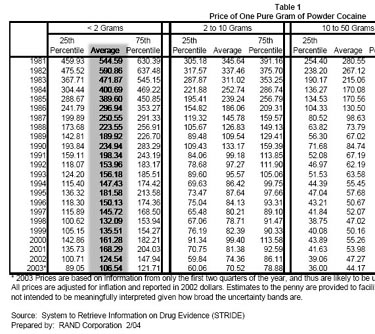« "People shouldn't be living there" | Main | Will nationalizing gas mean more money for Bolivia? »
May 2, 2006
Sen. Grassley takes on the drug czar
“[W]e have seen for the first time a decline in the purity of cocaine in the United States and an increase in price at the retail level … Roughly, in February of this year, cocaine availability in the United States, as measured in terms of purity and price, purity has gone down and price has gone up.”
Those were the words of White House Drug Czar John Walters six months ago, when he pulled together a press conference to announce new data showing that cocaine prices, as of September 2005, had risen to levels last seen in early 2004. Since then, Walters and other Bush administration officials have repeated that claim. (Recent examples include assistant Secretary of State for International Narcotics Anne Patterson [PDF format], Office of National Drug Control Policy (ONDCP) official David Murray).
The price rise, they say, is a proud achievement of Plan Colombia and the U.S. counter-drug strategy in the Andes. This strategy, of course, devotes much more resources to military force, eradication and interdiction than to development or rule-of-law improvements. Groups like CIP and WOLA voiced strong doubts about the November cocaine-price figures, which only showed a small short-term gain and ran counter to many other indicators that supplies of the drug are stable or even increasing.
But when it comes to calling into question the Drug Czar’s triumphal claims, nothing we can say will ever carry as much weight as the words of a Republican senator with a long track record as an architect of U.S. drug policy.
Sen. Charles Grassley (R-Iowa) has raised his voice to charge, essentially, that the Drug Czar’s office is cooking the books. In a strongly worded letter to John Walters dated April 26, Grassley charges him with using tentative and incomplete information to show progress where none may exist, and then to base policy decisions on what may be inaccurate claims.
Grassley’s letter deals another strong blow to the current anti-drug policy in the Andes; it shows that the strategy’s failure is becoming ever more obvious to everyone. Here are a few excerpts.
On Walters’ trumpeting of higher cocaine prices: “My principal concern is that these statements are based not only on data from sources that were never intended for such purposes, but that they also utilize data from different selected sources to provide a rosier but not necessarily more accurate, picture of the current situation.”
“I believe that these assumptions may be premature and perhaps even unfounded. Furthermore, these statements raise serious concerns within Congress about our ability to effectively combat the narco-traffickers.”
On the strange discrepancy between 1981-2003 cocaine-price data, which show 22 years of steady price decreases, and the 2003-2005 data presented at Walters’ November press conference: “I am also concerned about the reliability of these statements because, according to the 2004 report ‘Price and Purity of Illicit Drugs: 1981 Through the Second Quarter of 2003’, which is based on STRIDE [DEA “System to Retrieve Information from Drug Evidence”] data and is currently available on the ONDCP website, the price of a pure gram of cocaine during the first two months of 2003 was $106 (for less than 2 grams) and had not been above the $200 mark since 1990.”
Here, Grassley refers to a weird hiccup in official U.S. data. While DEA statistics were showing cocaine available on U.S. streets for about $106 per gram in mid-2003, the graph Walters presented at his press conference showed cocaine at over $200 per gram in July 2003. Here it is side-by-side:

(from page 58 of “Price and Purity of Illicit Drugs”)

(from Walters’ November press conference)
On the drug czar’s April announcement that coca cultivation was higher in Colombia in 2005, but lower in areas of Colombia that were previously measured: “ONDCP's April 14th press release regarding coca cultivation in Colombia references an eight percent reduction in those areas in 2005 that also were imaged in 2004. This is potentially misleading since it includes the areas that were heavily sprayed, which likely resulted in growers leaving those areas and moving to others. Research shows that those in the drug trade adapt to pressure to eradicate and interdict their product.”
“We have been concerned about the accuracy of the numbers for years due to their methodology. How do we even know that these numbers are accurate?”
Unrelated postscript added at 5:15 PM EDT: This, from yesterday's "In the Loop" column in the Washington Post, is too remarkable not to share.
Try Some Chips on Immigration?
The focus on immigration has sparked creative ideas on how to deal with the issue. Sens. Arlen Specter (R-Pa.) and Jeff Sessions (R-Ala.), on their recent trip to Latin America, picked up some unusual suggestions in a chat with Colombian President Alvaro Uribe .
The senators, according to an account Specter put in the Congressional Record, asked Uribe about seasonal workers who don't return home. Uribe had a nifty solution.
"President Uribe said he would consider having Colombian workers have microchips implanted into their bodies before they are permitted to enter the United States to work on a seasonal basis," Specter reported.
"I doubted whether the implantation of microchips would be effective," Specter reflected, "since the immigrant worker might be able to remove them."
Posted by isacson at May 2, 2006 2:05 PM
Trackback Pings
TrackBack URL for this entry:
http://ciponline.org/cgi-bin/mt-tb.cgi/228
Comments
Post a comment
Thanks for signing in, . Now you can comment. (sign out)
(If you haven't left a comment here before, you may need to be approved by the site owner before your comment will appear. Until then, it won't appear on the entry. Thanks for waiting.)